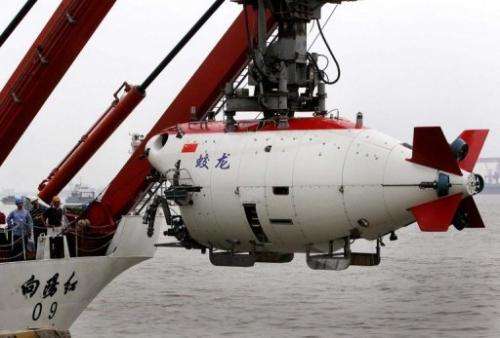This file photo, taken in 2011, shows the Chinese submersible 'Jiaolong.' The submersible broke through the 7,000-metre mark in an ocean dive on Sunday, state media said, setting a new national record for China.
A manned Chinese submersible broke through the 7,000-metre mark for a new national record on Sunday, state media said, as the rising Asian nation showed off its technological might.
The "Jiaolong" craft dived 7,015 metres (23,015 feet) in the Mariana Trench in the western Pacific Ocean on its fourth dive since arriving in the area earlier this month, the official Xinhua news agency said.
The dive came on the same day as China was attempting its first manual space docking, a complex manoeuvre that will bring the country a step closer to building a space station.
"This (dive) shows the performance of the submersible is stable," mission chief commander Liu Feng told state television in a live broadcast from aboard the ship supporting the submersible.
"The level of our technical personnel is getting better and better."
The Jiaolong -- named after a dragon from Chinese mythology -- carried three people into the Mariana Trench, the deepest place in the world.
Applause broke out as a depth gauge aboard the supporting ship Xiangyanghong registered more than 7,000 metres, state television showed.
The same submersible reached 5,188 metres in a Pacific dive in July last year. And in a series of three previous dives since June 15, the craft has gone deeper each time. Experts say 7,000 metres is the limit of its design.
Earlier this year, American film director James Cameron descended almost 11,000 metres to the bottom of the Mariana Trench.
His effort is believed to have at least equalled the record for the deepest manned dive, set by a US Navy officer and a Swiss oceanographer in 1960, according to Guinness World Records.
Experts say China intends to use the submersible for scientific research, such as collecting samples of undersea life and studying geological structures, as well as future development of mineral resources.
On its third dive on Friday, the crew collected samples of water and sediment and took photos of sea life, Xinhua said.
Scientists say the ocean floors contain rich deposits of potentially valuable minerals, but the extreme depths pose technical difficulties in harvesting them on a large scale.
And the stability and durability of the craft presents further problems for future operations.
The recent round of dives have seen some minor technical glitches, such as the breakdown of communications equipment and problems with the adjustable ballast system, state media has reported.
The 7,000 metre dive was previously scheduled for Monday, state media had reported. The reasons for the change of date were unclear but mean the record-setting dive comes the same day as China's landmark space manoeuvre.
(c) 2012 AFP
























